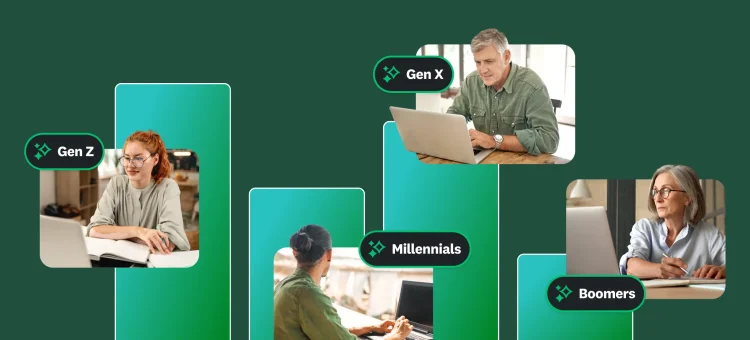How do you know what your customers really want? What happens when you think you’re offering your customers the moon (and more) but they still shop with your competitors?
Learn how your customers really feel by surveying them directly. Our ultimate guide to running a customer feedback program can show you how.
The best way to figure out what you’re lacking is to go through a transformation (or makeover if you’re so inclined). Ready? Grab a pen and paper (or gadget of your choice), close your eyes, and step out of your business briefs and into the customer’s shoes to get into the customer mindset. You’re going on a journey. A customer journey, that is.
What is the customer journey?
Think of the customer journey as a roadmap detailing how a customer becomes aware of your brand, their interactions with your brand–and beyond. Here’s the customer journey definition:
The customer journey is the complete sum of experiences that customers go through when interacting with your company and brand. Instead of looking at just a part of a transaction or experience, the customer journey documents the full experience of being a customer.
Phew. That’s a lot of ground to cover. But understanding the customer journey (and overall customer experience) isn’t as tricky as it seems once you get organized. And it is important. Here’s why:
Customer love=employee satisfaction
New research shows that companies with a customer-centric culture are significantly more likely to have happier, more loyal employees.
Getting to know the customer journey is about nurturing the customer experience
So often, when customers purchase a product or service, they’re anticipating that a pleasant feeling will accompany the purchase. There is a feeling of satisfaction, or a “high” people get from finding something they want, going through the process of purchasing it, and finally, enjoying what they bought. Customers notice this experience–the ease or hassle of it–even if you’re not consciously mapping out and planning the experience they will have.
To get a better sense of the customer journey, let’s get inside the customer mindset. And we’ll (ping) you every time you have an opportunity to explore, understand, and improve her experience.
A customer journey example
Your potential customer is shopping downtown and sees your storefront and signage (ping). She walks in and sees the the layout of your store (ping). Your employee greets her (ping) and offers her help (ping). The employee is also friendly (ping) and knowledgeable (ping) and helps her pick out a smashing pair of shoes (ping) that’s good quality (ping).
Your new customer is assured that if she does change her mind about her purchase, she’s able to return the shoes, no questions asked (ping). And you collect her email address for future promotions (ping). Later in the day, your customer tweets a picture of her new shoes and mentions your store (ping). She even recommends your store on yelp.com (ping), as she’s feeling loyal toward your brand (ping). A couple of weeks later, you send her a promotional email (ping) that offers her a discount (ping) and reminds her of your brand and its core values (ping).
That’s just one scenario. And, unfortunately, if you’re not paying attention or trying to understand the customer mindset, you may be selling your brand short. If the customer has a frustrating experience while shopping in your store (couldn’t find the product, the staff was rude, etc.), this matters and goes into the full sum that she will associate with your brand. If the customer wants to purchase the product again, she may consider going to a competitor’s store where the staff is friendlier or the store is better organized. And she may say negative things about your brand or store, using word of mouth to recommend people shop elsewhere.
Yikes! Now you can see why it’s important to pay attention to how customers experience your brand every step of the way. You can do this by mapping out the customer journey–or creating a customer journey map.
How to create a customer journey map
Still have your pen and paper? You’re going to sketch out a map (or timeline) that lays out every stage of the customer experience, just as we did above. These stages are customer touchpoints–basically any time a customer comes in contact with your brand. (You can get as granular as you’d like. Learn more about touchpoints in our free eGuide.)
Along the way, customers will interact with your various touchpoints, such as an ad or your website. Once you’re in the customer mindset, you can map out your touchpoints, which likely include:
When analyzing the stages and timeline your customers go through along a customer journey map, note the following:
- Actions: After you lay out the stages of your customer’s journey map (they hear about you through a review, visit your store, etc.), ask yourself what the customer is doing at each one of the stages.
- Motivations: What will encourage your customers (or discourage them) from moving to the next stage? What kinds of emotions do they feel in each one of the stages?
- Questions: Where do customers get hung up? Do they have questions and have a hard time finding answers? Could their uncertainties cause them to give up and find a different company? If your product is inherently complicated, could you improve the customer experience by proactively addressing questions your customers will have as they move through the stages?
- Obstacles: What kinds of obstacles do customers confront in each of the stages? Is cost a factor? The return policy? Think about anything that might cause the customer to give up and not complete the sales cycle while moving through the customer journey.
Use visuals to set up the customer journey map
You can map out the customer journey process through diagrams, or by creating a list of scenarios that customers are likely to encounter at every stage along their journey. If you are unsure of the steps that customers go through, ask them. Create customer feedback surveys to better understand their experiences with your brand.
Keep in mind that every customer’s journey will be slightly different, and some customers may skip stages altogether; this is why it’s important to create as many scenarios as you can and talk to your customers to learn about the journey they take when interacting with your brand.
When you’re ready, setting up software-based customer experience management can help you scale your efforts.
So invest time into understanding the customer journey and go through the process of documenting every time customers interact with your brand–the exercise will help you see where you can make improvements and show you how to make every customer experience a positive one. Happy mapping!




